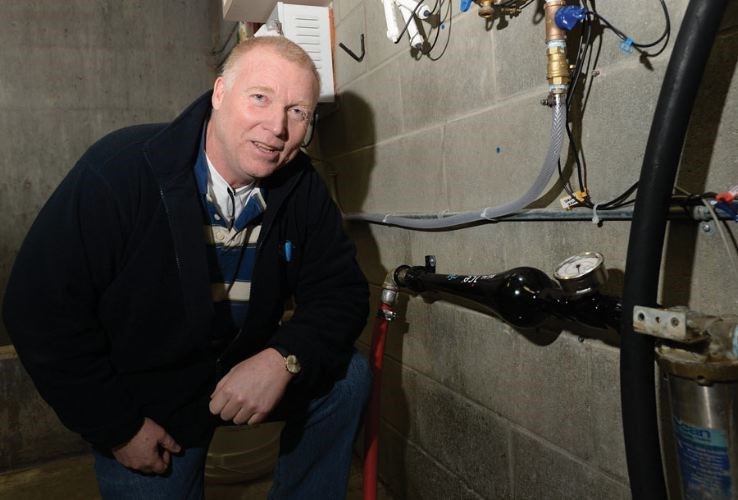The ice at CN Centre has been turned green.
Environmentally-friendly, that is.
And if everything goes as expected, the quality of the skating surface will be better than ever.
On Wednesday morning, the local arena began using a technology called REALice and will continue to do so until at least the end of February. With the adoption of REALice, CN Centre became part of a 10-week $300,000 pilot program funded by FortisBC. Rinks in Duncan, Mill Bay, Delta, Richmond, Vancouver, Kamloops, Kelowna, Castlegar and Nelson are also participating in the program.
REALice was introduced in 1998 in Malmo, Sweden, and is now used in all 11 of that city's rinks -- including the one that hosted this year's world junior hockey championship. The technology can be found in more than 250 arenas across Europe and has also made significant inroads with the National Hockey League.
Typically, the water used in resurfacing machines must first be heated because hot water contains fewer air bubbles and fewer air bubbles translates into harder, more durable ice. REALice is environmentally-friendly because it eliminates the need to heat the water.
"In easy terms, REALice is actually simulating warm water," said spokesman Hakan Gronlund, who was at CN Centre on Wednesday to help demonstrate the technology.
With the REALice system, cold water passes through a device that is mounted on a facility's main water pipe. The patented device creates a vortex or low pressure system, which separates air bubbles from the water. The water then travels through a hose and into the resurfacing machine. At that point, the separated air molecules naturally rise to the top of the holding tank and the water sinks to the bottom and is ready for use.
The environmental benefits of using the REALice technology include lower carbon dioxide emissions and reduced energy use.
For this pilot program, FortisBC estimates the 10 arenas around the province will cut their collective CO2 emissions by 500 tons, or the amount given off by about 400 small cars. In other terms, the amount of energy saved, according to FortisBC, would be enough to heat more than 300 homes and provide electricity to more than 220 homes.
As for ice quality, Gronlund said REALice technology has received positive reviews everywhere it has been installed.
"Our message is that we're saving money and we create as good as ice as you had before, and probably improve it," Gronlund said.
Gronlund, who in his younger years was a minor professional hockey player in Sweden, has done plenty of skating on ice that has benefited from the REALice method of resurfacing.
"It's a fast ice and it's a safer ice because you get less gouges in the ice," he said.
Rod Croome, energy initiatives supervisor with the City of Prince George, was present at CN Centre for Wednesday's first resurfacing using the REALice system and was impressed by everything he saw.
"It is very presentable ice and in fact it's better than it was [Tuesday] because of an adjustment," he said. "What we did between [Tuesday] and [Wednesday] was raise the ice temperature so it is having a very positive effect. Once we let this sit and form, we'll make some further increases in ice temperature and of course whenever we raise the ice temperature we're reducing the load on our refrigeration system and that's where the hydro savings will come into play."
Croome said the overall results will be assessed at the end of February.
"We will measure the gains and see how we go forward, but we will own the [REALice] equipment," he said. "That's part of the deal. It's fully-funded by Fortis so there's very little downside to us, with a lot of upside. To me, having a fully-funded pilot [program] was a no-brainer when they presented the potential energy saving. Of course that's what I want to do with our [city] facilities is reduce energy consumption."
Croome said he anticipates the continued use of REALice after the trial period ends.
"In fact, based on the results, we have five other arenas [Kins 1, 2 and 3, the Coliseum and the Elksentre] and we could consider expanding the program," he said. "In all of those facilities we are of course using hot water so if we can prove some savings here and make a business case for expanding, we would certainly entertain that."
Each rink would need its own REALice equipment, and the cost is $30,000 per unit.
Jim Kobialko, FortisBC's program manager for innovative technologies, said FortisBC would conceivably cover part of the cost.
"We would analyze the results of the pilot and part of our overall objective is to take these results and [determine] whether it makes sense for us to develop a full-scale program that will provide incentives for all ice rinks across British Columbia," he said. "Obviously we wouldn't cover the full cost of the install, we would determine what the appropriate amount of incentives would be."



